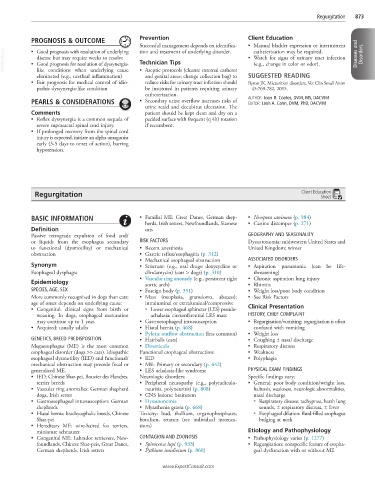Page 1738 - Cote clinical veterinary advisor dogs and cats 4th
P. 1738
Regurgitation 873
PROGNOSIS & OUTCOME Prevention Client Education
Successful management depends on identifica- • Manual bladder expression or intermittent
VetBooks.ir • Good prognosis for resolution of dyssynergia- Technician Tips • Watch for signs of urinary tract infection Diseases and Disorders
tion and treatment of underlying disorder.
catheterization may be required.
• Good prognosis with resolution of underlying
disease but may require weeks to resolve
(e.g., change in color or odor).
like conditions when underlying cause
and genital areas; change collection bag) to
eliminated (e.g., urethral inflammation) • Aseptic protocols (cleanse external catheter SUGGESTED READING
• Fair prognosis for medical control of idio- reduce risks for urinary tract infection should Byron JK. Micturition disorders. Vet Clin Small Anim
pathic dyssynergia-like condition be instituted in patients requiring urinary 45:769-782, 2015.
catheterization.
PEARLS & CONSIDERATIONS • Secondary urine overflow increases risks of AUTHOR: Joan R. Coates, DVM, MS, DACVIM
EDITOR: Leah A. Cohn, DVM, PhD, DACVIM
urine scald and decubitus ulceration. The
Comments patient should be kept clean and dry on a
• Reflex dyssynergia is a common sequela of padded surface with frequent (q 4h) rotation
severe suprasacral spinal cord injury. if recumbent.
• If prolonged recovery from the spinal cord
injury is expected, initiate an alpha-antagonist
early (3-5 days to onset of action), barring
hypotension.
Regurgitation Client Education
Sheet
BASIC INFORMATION • Familial ME: Great Danes, German shep- • Neospora caninum (p. 984)
herds, Irish setters, Newfoundlands, Siamese • Canine distemper (p. 271)
Definition cats
Passive retrograde expulsion of food and/ GEOGRAPHY AND SEASONALITY
or liquids from the esophagus secondary RISK FACTORS Dysautonomia: midwestern United States and
to functional (dysmotility) or mechanical • Recent anesthesia United Kingdom; winter
obstruction • Gastric reflux/esophagitis (p. 312)
• Mechanical esophageal obstruction ASSOCIATED DISORDERS
Synonym • Stricture: (e.g., oral drugs: doxycycline or • Aspiration pneumonia (can be life-
Esophageal dysphagia clindamycin) (cats > dogs) (p. 310) threatening)
• Vascular ring anomaly (e.g., persistent right • Chronic aspiration lung injury
Epidemiology aortic arch) • Rhinitis
SPECIES, AGE, SEX • Foreign body (p. 351) • Weight loss/poor body condition
More commonly recognized in dogs than cats; • Mass (neoplasia, granuloma, abscess): • See Risk Factors
age of onset depends on underlying cause: intraluminal or extraluminal/compressive Clinical Presentation
• Congenital: clinical signs from birth or ○ Lower esophageal sphincter (LES) pseudo-
weaning. In dogs, esophageal maturation achalasia: circumferential LES mass HISTORY, CHIEF COMPLAINT
may continue up to 1 year. • Gastroesophageal intussusception • Regurgitation/vomiting: regurgitation is often
• Acquired: usually adults • Hiatal hernia (p. 468) confused with vomiting
• Pyloric outflow obstruction (less common) • Weight loss
GENETICS, BREED PREDISPOSITION • Hairballs (cats) • Coughing ± nasal discharge
Megaesophagus (ME) is the most common • Diverticula • Respiratory distress
esophageal disorder (dogs >> cats). Idiopathic Functional esophageal obstruction: • Weakness
esophageal dysmotility (IED) and functional/ • IED • Polyphagia
mechanical obstruction may precede focal or • ME: Primary or secondary (p. 642)
generalized ME. • LES achalasia-like syndrome PHYSICAL EXAM FINDINGS
• IED: Chinese Shar-pei, Bouvier des Flandres, Neurologic disorders: Specific findings vary:
terrier breeds • Peripheral neuropathy (e.g., polyradiculo- • General: poor body condition/weight loss,
• Vascular ring anomalies: German shepherd neuritis, polyneuritis) (p. 808) halitosis, weakness, neurologic abnormalities,
dogs, Irish setter • CNS lesions: brainstem nasal discharge
• Gastroesophageal intussusception: German • Dysautonomia ○ Respiratory disease: tachypnea, harsh lung
shepherds • Myasthenia gravis (p. 668) sounds, ± respiratory distress, ± fever
• Hiatal hernia: brachycephalic breeds, Chinese Toxicity: lead, thallium, organophosphates, ○ Esophageal dilation: fluid-filled esophagus
Shar-pei botulism, tetanus (see individual intoxica- bulging at neck
• Hereditary ME: wire-haired fox terriers, tions)
miniature schnauzer Etiology and Pathophysiology
• Congenital ME: Labrador retrievers, New- CONTAGION AND ZOONOSIS • Pathophysiology varies (p. 1277)
foundlands, Chinese Shar-peis, Great Danes, • Spirocerca lupi (p. 933) • Regurgitation: nonspecific feature of esopha-
German shepherds, Irish setters • Pythium insidiosum (p. 860) geal dysfunction with or without ME
www.ExpertConsult.com

